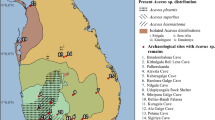Abstract
Palynological and geochronological data have been used to ascertain the time history of a unique natural-territorial complex — the relict larch stands that have persisted in the southeastern part of Shikotan Island since the Late Pleistocene. The study revealed the development stages of landscapes. Factors favoring vegetation conservation in the refugium are discussed.
Similar content being viewed by others
References
Krestov, P.V., Barkalov, V.Yu., Omel’ko, A.M., Yakubov, V.V., Nakamura, Yu., and Sato, K., Relict Vegetation Complexes of Contemporary Refugia in Northeastern Asia, Komarovskie chteniya, 2009, issue 56, pp. 5–63 [in Russian].
Velichko, A.A., Main Features of Landscape Changes on the Territory of Northern Eurasia in the Late Pleistocene and Holocene, in Dynamics of Landscape Components and Inland Sea Basins of Northern Eurasia for the Last 130 000 Years (General Palaeography), Ed. A.A. Velichko, Moscow: GEOS, 2000 [in Russian].
Urusov, V.M. and Chipizubova, M.N., Vegetation of the Kurils: Questions of the Dynamics and Origin, Vladivostok: Dal’nauka, 2000 [in Russian].
Zhuravlev, Yu.I. and Sazonova, I.Yu., Formation of Species Diversity of Kuril Biota, in Vegetation and Animal World of the Kuril Islands (Materials of the International Kuril Project), Vladivostok: Dal’nauka, 2002 [in Russian].
Bennet, K.D. and Provan, J., What Do We Mean by ‘Refugia’? Quatern. Sci. Rev., 2008, vol. 27,issues 27–28, pp. 2449–2455.
Barkalov, V.Yu., Flora of the Kuril Islands, Vladivostok: Dal’nauka, 2009 [in Russian].
Igarashi, Y., Murayama, M., Igarashi, T., Higake, T., and Fukuda, M., History of Larix Forest in Hokkaido and Sakhalin, Northeast Asia, Since the Last Glacial, Acta Palaeontologica Sinica, 2002, vol. 41, no. 4, pp. 524–533.
Igarashi, Ya., Yamamoto, M. and Ikehara, K., Climate and Vegetation in Hokkaido, Northern Japan, Since the LGM: Pollen Records From Core GH02-1030 off Tokachi in the Northwestern Pacific, J. Asian Earth Sci., 2011, vol. 40,issue 6, pp. 1102–1110.
Handbook on the USSR Climate, Leningrad: Gidrometeoizdat, 1968, Pt. 5 (Cloudiness), Pt. 3 (Wind) [in Russian].
Yoshimoto, M., Hasegawa, T., Kishimoto, H., and Nakagawa, M., Hokkaido University Volcanology Field Course in Hokkaido, Sapporo: Hokkaido University Press, 2006.
Modern and Holocene Volcanism in Russia, Ed. N.P. Laverov, Moscow: Nauka, 2005 [in Russian].
Razzhigaeva, N.G., Ganzei, L.A. and Belyanina, N.I., First Data on Landscape Evolution in the Southern Kurile Islands at the Pleistocene-Holocene Transition, Doklady Earth Sciences, vol. 430,issue 1, pp. 108–113.
Razzhigaeva, N.G., Ganzei, L.A., Belyanina, N.I., and Grebennikova, T.A., Stratigraphy of Peat Bog in the Gorobets River valley and Development of Natural Environments of Shikotan Island (Lesser Kurile Ridge) in the Holocene, Russian Journal of Pacific Geology, vol. 2,issue 4, pp. 354–369.
Tsukada, M., A Vegetation Map of the Japanese Archipelago Approximately 20,000 Years B.P., JJEC, 1984, vol. 34, no. 2, pp. 203–208.
Koizumi, I., Spectral Analysis of the Diatom Paleo-temperature Records at DSDP Sites 579 and 580 Near the Subarctic Front in the Western North Pacific, Palaeogeogr. Palaeoclim. Palaeoecol., 1994, vol. 108, nos. 3–4, pp. 475–485.
Kawahata, H., Ohshima, H., Shimada, C., Oba, T., Terrestrial-Oceanic Environmental Change in the Southern Okhotsk Sea During the Holocene, Quaternary International, 2003, vol. 108,issue 1, pp. 67–76.
Author information
Authors and Affiliations
Corresponding author
Additional information
Original Russian Text © N.G. Razzhigaeva, N.I. Belyanina, L.A. Ganzei, Kh.A. Arslanov, S.B. Chernov, 2013, published in Geography and Natural Resources, 2013, Vol. 34, No. 2, pp. 125–131.
Rights and permissions
About this article
Cite this article
Razzhigaeva, N.G., Belyanina, N.I., Ganzei, L.A. et al. The origin and evolution of relict larch stands on Shikotan Island (Lesser Kuril Ridge) in the Holocene. Geogr. Nat. Resour. 34, 179–184 (2013). https://doi.org/10.1134/S187537281302011X
Received:
Published:
Issue Date:
DOI: https://doi.org/10.1134/S187537281302011X




